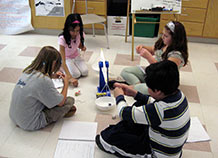How can we measure the weights of our cubes?
1. Ask the question
Gather students around the three demonstration cubes placed in weight order: pine, oak, and copper. Introduce the idea of “relative weight.”
- I put the 3 cubes in order from lightest to heaviest, but do you know more about the weights of the 3 cubes that we do not see?
- How could we arrange the cubes to show how much heavier the copper cube is than the others?
Let students brainstorm some ideas. Create a weight line for the class, and reinforce the understanding that the weight line shows us not only the weight order; it also shows that the two wood cubes are close in weight, while the copper cube is much heavier than either of them.


Top: Pine, oak and copper cubes in order by weight.
Bottom: Pine, oak and copper cubes on the weight line ordered by “relative weight”.
- How much heavier is the copper cube?
Let the students know that today’s investigation will help them figure out how much each cube weighs, and how far apart they should be on the weight line. Introduce the investigation question:
Remind students that in the last session they used the pan balance to compare two cubes.
- How could we use the pan balance to measure the weight of a cube?
As they share their ideas, set up a pan balance and place the aluminum cube in one pan. Then invite a volunteer to try to weigh the cube using a piece of plastic modeling clay.
Note: Plastic modeling clay is actually not a very satisfactory material for weighing the aluminum cube; there is no clear way to describe the weight once you’ve finished. However, the plastic modeling clay provides a model for how to use the pan balance with a counterweight without suggesting how the students should use the specific counters (paper clips, washers, and bears) they are given.

Check to see that everyone understands how to use the pan balance in this new way. Acknowledge that the plastic modeling clay gives only a very general idea of the weight of the cube. (The aluminum cube weights about the same as a small glob of plastic modeling clay). Let students know that their measurements will be more precise because they will weigh their cubes using objects that they can count. Show students the collection of paper clips, steel washers, and plastic bears. Distribute the collection, the cubes, and the pan balances to the students. Students will weigh the three cubes in the pan balance and record their findings.



